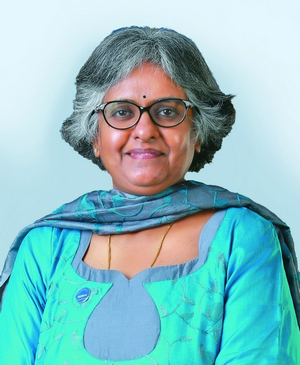
Shalini Warrier foresees banking domain to see emergence of anything from digital assistant banking to the AI customer support
Federal Bank has a 2-pronged strategy for digital transformation and engagement and the bank looks to leverage its existing digital capabilities to enhance customer satisfaction, reduce cost of operations and provide a smooth and enriching customer experience. At the same time, it continually tries to innovate and experiment with new technologies that can provide better service to the customers in future.
Elaborating this strategy further, Shalini Warrier, chief operations officer of the bank, says: “Take our product BYOM (Be Your Own Master) for instance. With this offering, existing customers of the bank, who are eligible for pre-approved personal loans can avail of these loans with the click of a button. This has enabled us to build a large personal loan book. Similarly, on the innovation front, we have recently launched our new cross-border remittance product, which is based on blockchain technology.”
She points out that the bank takes to its our vision statement – ‘To be the Most Admired Bank’ – with inspiration. “We’re now digitally enabled with a sharp focus on micro, medium and mid-size enterprises. This is the central theme around which all our strategies are developed. To be the most admired bank in a highly competitive environment, we believe in speed and impeccable quality of service to customers,” she explains.
2 HITS WITH ONE STONE
“For us, digital transformation is the stone that allows us to target two birds at the same time – operational/service efficiency and customer engagement,” says she.
With 43% increase in share of digital transactions yoy, a digital loan book of Rs5.15 billion and initial strides in applications of blockchain technology to name a few, the bank’s digital transformation has been highly fulfilling.
Shalini Warrier maintains that Federal Bank has been one of the first movers in the BFSI space to embrace digital transformation in the country. The digital transformation journey started way back in 2004, when it launched FedNet, the internet banking solution. Since then, it has continued to be a bank of many firsts, most significant of the accomplishments being the first to launch: (i) a fully digital passbook application, FedBook, and (ii) FedBook Selfie, which is India’s first app-based account opening solution as an upgrade to FedBook. “These solutions were instant hits, garnering attention of tech savvy customers,” she adds.
PLATFORM FOR FINTECHS
The bank has recently introduced FedAlert, a mobile app for instant, secure and assured delivery of alerts over push notifications. Its open banking platform enables fintech players and startups to consume banking APIs and deliver robust and innovative solutions to a wider set of tech savvy, enthusiastic consumers. There are regular updates to core mobile banking applications in line with latest usability and security trends. To ensure ease of account opening, whether in the branch or at the customer’s site, the bank has leveraged eKYC capabilities to offer a digital account opening experience.
“Suffice to say that we’ve reinvented ourselves consistently to better serve customers with modern technology led innovative offerings, and healthy competition has always made us push the envelope further,” avers Shalini Warrier.
UNIQUE REMITTANCE TOOL
She hastens to add that in a highly competitive market, customers seek efficiency in a jiffy and convenience at the click of a button. “Being at the forefront in technology-led innovation in banking, we are always on the lookout for innovative solutions for modern problems. For us, efficiency is a function of speed, accuracy and reliability. Technologies like blockchain help us catalyze this function and the result, as I pointed out earlier, has been highly rewarding. Our blockchain powered remittance solution facilitates secure, seamless and speedy cross-border transactions – all the while helping us lower costs consistently. While we are looking to further enhance the scope of application of this technology, we are also exploring banking use cases and relevant applications of technologies such as behavioral biometrics, IoT, AI/ML and NLP to enhance customer experience at every stage/step of their engagement lifecycle with our bank.”

When she talks of fintechs being promoted on the banking platform, does she think fintechs are competition for banks?
“No way,” she says, adding: “In fact, we consider them strategic partners sailing the same digital ocean, striving for service excellence at every level. To put it simply, we look to collaborate with them for mutual benefit. While there are several examples of our mutually successful partnerships, let me give you the most recent partnerships:
(i) IndiaLends, which is digital credit services; and
(ii) Matchmove, which is enterprise mobile wallet and payment card solutions; and
(iii) A-HOPE, which is an integrated mobile platform connecting farmers, farmer produce organizations, farm service providers, procurement agents, processing centers and markets.”
VARIED USES OF AI/ML
In this scheme of things, how is the bank preparing itself to make use of AI/ML and similar technologies to bring in efficiency and better customer experience?
Says Warrier: “AI/ML and related technologies are pretty vast topics and the frontiers are still being explored. There is no doubt that these technologies create significant impact on businesses and society alike. Many breakthroughs are being made as we speak, and the times are indeed exciting. Efficiency is the key and we welcome any technology that helps us raise the bar further. Apart from encouraging our talent to learn, embrace and upskill in these fields, we are partnering with forward looking firms that bring superior applications to the table.”
Specific areas of innovation that the bank is engaged in currently include the use of blockchain for cross-border remittances, facial recognition for internal access control in the head office, AI/ML for answering queries and clarifications from branch staff and the use of Robotic Process Automation (RPA) in automating repetitive jobs in operational areas.
BANKING 5 YEARS FROM NOW
In this scenario where banks are increasingly developing systems and tools that are based on AI and ML, how does she visualize the banking to be, in 5 years from now?
“The pace and scale of technology disruption is truly fascinating,” says she, adding: “Five years from now, we could possibly be seeing anything from digital assistant banking to the first AI customer support executives! I believe behavioral biometrics, IoT, blockchain, ML and NLP would be the technology paradigms that promise to reshape the future of banking. Employees will be freed from repetitive, low-value tasks to focus on upstream, high-value work that actually unlocks more value for the business.”
“That said, our core theme ‘Digital at the fore, human at the core’ will, in our view, continue to thrive in future. Employees will continue to be engaged with customers in the more evolved areas of advisory services and areas requiring the exercise of qualitative judgements.”
Does that mean traditional, branch-centric banking continue to exist or will a fully digitized, online banking model replace it?
Responds Warrier: “Digital banking will no doubt be the way ahead, but it is still too early to predict timeframes or even the magnitude of its impact. So yes, branch-centric banking is here to stay, at least for the near term. Human psychology still has a major say in the way business is conducted and human relations have their value always. However, the real question is, will branch-centric banking continue to exist in its current avatar, or would it evolve. The answer could be open to debate, but our motto, as I explained earlier, has us adequately equipped to adapt to any scenario in future.”
EXPERIMENT WITH ANALYTICS
One unique task the bank has undertaken is to make use of analytics to understand the way ATMs are used and accordingly make strategic decisions. The bank has over 1800 ATMs across the length and breadth of the country and millions of transactions are processed through this network. Warrier says one of the challenges the bank faced was the ability to crunch the data from these ATMs to ascertain the ideal location of the ATMs, the hours when they were being used the most, and the specific functionalities that customers found most useful. “We, with the help of Oracle Autonomous Database Cloud service in conjunction with Oracle Analytics Cloud service, could overcome the challenges and analyze data faster, in a more predictive fashion, and gain more actionable insights faster. This has helped us to deliver new functionalities to end customers. One tangible outcome of this effort is that we now are able to offer customers the facility of updating their mobile numbers via the ATMs. We’ve also been able to ensure our ATMs are strategically located (in the right places, with high footfalls). In effect, Oracle’s Autonomous Database has freed up our time in application of technology rather than maintenance and this has ultimately started to translate into business success for us,” says Warrier.







